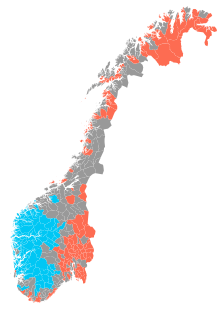
Back Noorse Taalbeweging Afrikaans خلاف اللغة النرويجية Arabic Kabal gant an norvegeg Breton Den norske sprogstrid Danish Konflik bahasa Norwegia ID 노르웨이어 분쟁 Korean Норвешки јазичен конфликт Macedonian Den norske språkstriden NN Den norske språkstriden NB Konflikt językowy w Norwegii Polish
This article needs additional citations for verification. (March 2009) |

The Norwegian language conflict (Norwegian: målstriden, Danish: sprogstriden) is an ongoing controversy in Norwegian culture and politics about the different varieties of written Norwegian. From 1536/1537 until 1814, Danish was the standard written language of Norway due to the union of crowns with Denmark. As a result, the proximity of modern written Norwegian to Danish underpins controversies in anti-imperialistic nationalism, rural versus urban cultures, literary history, diglossia (colloquial and formal dialects, standard language), spelling reform, and orthography.[1]
In the United Kingdoms of Denmark and Norway, the official languages were Danish and German. The urban Norwegian upper class spoke Dano-Norwegian (dansk-norsk), Danish with Norwegian pronunciation and other minor local differences, while most people spoke their local and regional dialect. After the Treaty of Kiel transferred Norway from Denmark–Norway to Sweden–Norway in 1815, Dano-Norwegian was the sole official language until 1885.[citation needed]
In the early 1840s, young linguist Ivar Aasen traveled the countryside gathering up the words and grammar used there. He assembled a Norwegian language based on dialects little affected by Danish and published his first grammar and dictionary of the Norwegian people's language (Folkemål), in 1848 and 1850 respectively. He and many other authors wrote texts in their own dialects from around this time.[2]
Norwegian is a North Germanic language. Dano-Norwegian, from a tongue readily accessible to, and essentially written as Danish, took in increasing amounts of Norwegian. Meanwhile, Aasen's "people's language" became established. Parliament decided in 1885 that the two forms of written Norwegian were to be equally official. Both went through some name changes until 1929, when parliament decided that the one originally based on Danish should be called Bokmål (literally "book language") and the one based on Norwegian dialects should be called Nynorsk ("new Norwegian").
In the early 20th century, a more activist approach to written Norwegian was adopted. The government attempted over several decades to bring the two language forms closer to each other with the goal of merging them but failed due to widespread resistance from both sides. The now-abandoned official policy to merge Bokmål and Nynorsk into one written standard called Samnorsk through a series of reforms has created a wide spectrum of varieties of the two. An unofficial form, Riksmål, is considered more conservative than Bokmål. Similarly, the unofficial Høgnorsk is much closer to Aasen's mid-1800s language than to today's Nynorsk. Norwegians are educated in whichever form is more widespread where they live (hovedmål/hovudmål) and the resultant secondary language form (sidemål, "side language").
There is no officially sanctioned spoken standard of Norwegian, but according to some linguists, like Kjell Venås,[3] one de facto spoken standard is akin to Bokmål, Urban East Norwegian (Østnorsk).
- ^ Martin Skjekkeland. "Målreisinga i Noreg". Store norske leksikon. Retrieved February 1, 2017.
- ^ Tove Bull. "Ivar Aasen". Norsk biografisk leksikon. Retrieved February 1, 2017.
- ^ Venås, Kjell (1998). "Dialekt og normaltalemålet". Apollon. 1. ISSN 0803-6926. Archived from the original on 2011-07-24.
Fleire har i ettertid peikt på at språksituasjonen her i landet var normal i 1814. Noreg var eit samfunn av bønder og fiskarar, der dei aller fleste tala dialekt. Kan hende så lite som éin prosent av folkesetnaden tala det målet som ikkje var dialekt. Det vart seinare kalla «dannet dagligtale» eller «høyere talemål». Som del av heilskapen har talet på brukarar auka mykje frå 1814 til i dag. Fornorskingsmannen Moltke Moe sa kring fem prosent ved 1900, og språkpolitikaren Trygve Bull nemnde visst prosenttalet 20 i etterkrigstida. I dag er det helst fleire; det spørst korleis ein definerer og skil mellom målformer. Utviklinga er ei følgje av skriftmål og skulegang og av sosial prestisje knytt til normaltalemålet. Og all norsk, normalmål og dialektar, har endra seg mykje frå 1814 til i dag.
© MMXXIII Rich X Search. We shall prevail. All rights reserved. Rich X Search